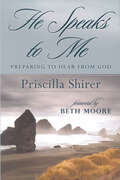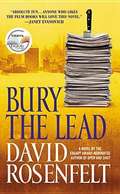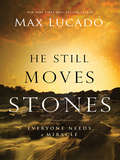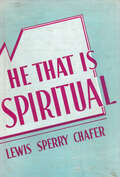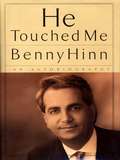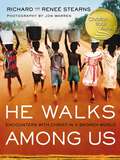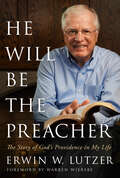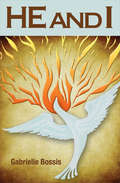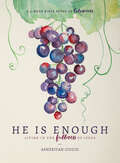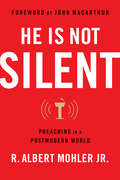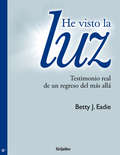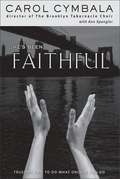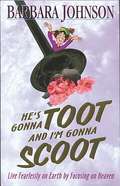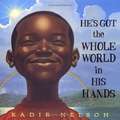- Table View
- List View
He Speaks to Me: Preparing to Hear the Voice of God
by Priscilla Shirer&“When we approach God humbly and bow down before Him, we put ourselves in a position to hear from Him.&”Are you longing to hear God&’s voice, but feeling disconnected?God wants to speak directly to each of His beloved children, not to just a few &“spiritual elite.&” Priscilla Shirer looks at God&’s call to Samuel and uncovers six characteristics essential for hearing from God: A simple RELATIONSHIP, unfettered by sin or prideA single-minded WORSHIP, focused on God and His gloryA set-apart HOLINESS, determined to live a life that honors HimA still ATTENTIVENESS, willing to be silent before HimA sold-out HUNGER, passionately pursuing God&’s presenceA servant SPIRIT, submitted to God&’s callHer warmth and honesty, combined with a wealth of practical help, will inspire you to cultivate these traits in your own life. By doing so, you will prepare yourself to draw closer to Him and to hear His voice more clearly.
He Speaks to Me: Preparing to Hear the Voice of God
by Priscilla Shirer&“When we approach God humbly and bow down before Him, we put ourselves in a position to hear from Him.&”Are you longing to hear God&’s voice, but feeling disconnected?God wants to speak directly to each of His beloved children, not to just a few &“spiritual elite.&” Priscilla Shirer looks at God&’s call to Samuel and uncovers six characteristics essential for hearing from God: A simple RELATIONSHIP, unfettered by sin or prideA single-minded WORSHIP, focused on God and His gloryA set-apart HOLINESS, determined to live a life that honors HimA still ATTENTIVENESS, willing to be silent before HimA sold-out HUNGER, passionately pursuing God&’s presenceA servant SPIRIT, submitted to God&’s callHer warmth and honesty, combined with a wealth of practical help, will inspire you to cultivate these traits in your own life. By doing so, you will prepare yourself to draw closer to Him and to hear His voice more clearly.
He Speaks to You
by Helena BurnsDiscerning your vocation can be difficult. But endowed with the spiritual guidance contained within this book, and with Jesus as your lifelong coach, you'll be on your way.
He Started the Whole World Singing: A Treasury of Gaither Christmas Songs, Reflections, and Holiday Traditions
by Gloria GaitherWhat better way to capture the spirit of this glorious season than this offering of a Gaither family Christmas? Gloria Gaither's Christmas lyrics quickly become everybody's favorite songs of the season. Here Gloria explores the meaning behind the lyrics and the stories of how they came to be written. And for a real treat, Gloria shares eighteen of her favorite seasonal recipes sure to make your mouth water. In this ideal Christmas celebration, you can almost hear the fire crackling, smell the turkey and cinnamon buns baking-and, just maybe, notice the swish of angel wings.
He Still Moves Stones
by Max LucadoIt's what happens when obstacles prevent you from seeing what God has done for you ... He still moves stones. People with questions. The Bible is absolutely full of them. A crook on a cross. A wild man in a cemetery. A five-time divorcée. A despondent cripple. A grieving sister. A father at the end of his rope. Why are these portraits in the Bible? So we can look back in amazement at what Jesus did? No ... these aren't just Sunday school stories. They are historic moments in which a real God met real pain so we could answer the question. "Does God care when I hurt?" On every page of this powerfully moving book, Max Lucado reminds us, the God who spoke to Moses at the burning bush still speaks loudly to you today. The God who forgave King David still offers you forgiveness. The God who helped men and women in ages past still comes into your world, and he comes to do what you can't, to move the stone away so you can see his answer.
He Still Moves Stones
by Max LucadoPeople with questions. The Bible is absolutely full of them. A crook on a cross. A wild man in a cemetery. A five-time divorcTe. A despondent cripple. A grieving sister. A father at the end of his rope.Why are these portraits in the Bible? So we can look back in amazement at what Jesus did? No ... these aren't just Sunday school stories. They are historic moments in which a real God met real pain so we could answer the question. "Does God care when I hurt?"On every page of this powerfully moving book,New York Times best-selling author Max Lucado reminds us that the God who spoke to Moses at the burning bush still speaks to you today. The God who forgave King David still offers you forgiveness. The God who helped men and women in ages past still comes into your world, and he comes to do what you can't, to move the stone away so you can see his answer.
He That Is Spiritual
by Lewis Sperry ChaferA book on the Holy Spirit and the life of an effective Christian by a past president of Dallas Seminary.
He That Is Spiritual
by Lewis Sperry ChaferHe That Is Spiritual defines true Christian living and unpacks the Bible concerning spirituality: what it is and how it is secured.
He That Is Spiritual
by Lewis Sperry ChaferHe That Is Spiritual defines true Christian living and unpacks the Bible concerning spirituality: what it is and how it is secured.
He Touched Me
by Benny HinnThis is the remarkable story of Benny Hinn-a man known to millions as one of the great healing evangelists of our time. Many who have attended his crusades, watched his daily television ministry, or have seen him on programs such as Larry King Live have asked, "Who is this man? And how did he rise to such a place of prominence?"You'll travel to Jaffa, Israel, and learn of the events that shaped the life of Benedictus, the oldest son in a family of eight children of Greek and Armenian heritage. And you will read of the deep conflicts in the Hinn household when, after the family immigrated to Canada, Benny had a dramatic, life-changing spiritual experience.The journey from a small church in Oshawa, Ontario, to the largest stadiums and arenas in the world is filled with love, laughter, and tears. It is also a story of miracles.He Touched Me, the autobiography of Benny Hinn, will inspire you. It reveals what can heppen when one person becomes totally yielded to the holy Spirit.
He Walks Among Us: Encounters with Christ in a Broken World
by Richard StearnsGod sees the poor as blessed. Rich and Reneé Stearns show us why. We often separate ourselves from people who are different from us, sometimes even intentionally. This book is a great reminder of all the things we share in common--hopes, dreams, heartaches--and most important of all, it reminds us that He walks among us. All of us. This book offers great perspective from our brothers and sisters around the world. Rich and Reneé Stearns have traveled the world visiting the most poverty-stricken habitations imaginable, and they've discovered an amazing and common occurrence among the people who live there: joy can be found no matter how dire your circumstances. He Walks Among Us is a 90-day devotional giving readers an up-close and personal view of Christ in the lives of mothers, fathers, and children who have so little, yet are so rich in His spirit and love. Christians who are interested in or committed to missionary outreach will encounter the transforming power and courage needed to make a difference in someone else's life. Spiritual lessons include: The Choice to Believe--No Matter What; Our True Identity Is in Christ; Discovering Joy in Unexpected Places; Having Unshakable Hope in the Power of God; Our Circumstances Don't Define Who We Are; We Become Transformed When We Invest in Others; and Remaining Faithful to Your Calling No Matter the Obstacles. He Walks Among Us features the award-winning photography of World Vision® photographer Jon Warren.
He Walks with Me: Enjoying the Abiding Presence of God
by Warren W. WiersbeDo you find yourself living in regret and fear more than in today's reality? God calls us to serve Him in the current moment rather than worry about the past or the future.In He Walks with Me, Dr. Warren W. Wiersbe explores the I AM statements of God--from His burning-bush conversation with Moses, to His powerful reassurances to the Israelites, to Jesus's startling claims to be the Light of the World, the Good Shepherd, and the True Vine. The more we understand the truths behind these words, the more free we are to enjoy God's presence right now. As Dr. Wiersbe writes, "My past may discourage me and my future may frighten me, but the life I now live today can be enriching and encouraging because Christ lives in me."
He Will Be the Preacher: The Story of God's Providence in My Life
by Erwin W. Lutzer"He will be the preacher." Whether this was just an offhand remark or the woman leaning over his crib was speaking under inspiration from the Holy Spirit, either way, her prediction came to pass.This is the story of a shy, wisecrack kid from rural Canada becoming a well-known American preacher. It&’s a story of seemingly random events deciding one man&’s destiny. But most of all, it&’s a story of God leading one of His dear children along.Join Erwin Lutzer on this tour of his life—from a Saskatchewan farm to a Dallas seminary to the historic Moody Church in Chicago. Hear his personal reflections and tales of pastoral hardship. Meet the people who have shaped him: his parents, professors, family, and even the great evangelist Billy Graham. And see how his many roles—author, speaker, evangelist, historian, and cultural critic—have carried his prophetic voice beyond Moody&’s pulpit, even abroad.Part story and part reflection, full of heart with a dose of wit, He Will Be the Preacher is a personal and engaging witness to the providence of God.
He Will Be the Preacher: The Story of God's Providence in My Life
by Erwin W. Lutzer"He will be the preacher." Whether this was just an offhand remark or the woman leaning over his crib was speaking under inspiration from the Holy Spirit, either way, her prediction came to pass.This is the story of a shy, wisecrack kid from rural Canada becoming a well-known American preacher. It&’s a story of seemingly random events deciding one man&’s destiny. But most of all, it&’s a story of God leading one of His dear children along.Join Erwin Lutzer on this tour of his life—from a Saskatchewan farm to a Dallas seminary to the historic Moody Church in Chicago. Hear his personal reflections and tales of pastoral hardship. Meet the people who have shaped him: his parents, professors, family, and even the great evangelist Billy Graham. And see how his many roles—author, speaker, evangelist, historian, and cultural critic—have carried his prophetic voice beyond Moody&’s pulpit, even abroad.Part story and part reflection, full of heart with a dose of wit, He Will Be the Preacher is a personal and engaging witness to the providence of God.
He and I
by Gabrielle BossisIn this timeless spiritual testament, readers enter into the intimate, interior conversations between Jesus and Gabrielle Bossis, a French nurse and playwright. Recorded in her diary from 1936 to 1950, their tender exchanges capture Jesus' enduring presence in our daily lives, his insistence on kindly serving others, and his encompassing love for humanity--and show that ordinary individuals can experience an intimacy with Christ.
He estado pensando: Reflexiones, oraciones y meditaciones para una vida plena
by Maria ShriverUn libro de reflexiones para aquellos que buscan sabiduría, orientación, ánimo e inspiración en el camino hacia una vida plena. Como mujer prominente que asume diferentes roles, Maria Shriver sabe perfectamente cuán sorprendente, impredecible y estresante puede resultar la vida diaria. En este emotivo y poderoso libro, la autora comparte pasajes inspiradores, oraciones y reflexiones creados para hacer pensar, hacer sentir, hacer reír y ayudar a los lectores en su viaje a lo que ella llama “El campo abierto”—un lugar de aceptación, propósito y pasión—un lugar lleno de alegría. He estado pensando... (I've Been Thinking...) es ideal para cualquier persona en cualquier momento de su vida. Ya sea porque crees que todo está bien o porque el mundo se te cae a pedazos—sea porque estás evaluando tu vida o simplemente porque necesitas recargar energías, este es el libro al que te dirigirás una y otra vez. Es como hablar con un amigo cercano, es la compañía perfecta—un regalo excepcional para alguien que busque seguir adelante en la vida con gracia y esperanza.
He is Enough: Living in the Fullness of Jesus (A Study in Colossians)
by Asheritah CiuciuDiscover the Secret to a Full LifeWe live in a world of scarcity. We say, &“I don&’t have enough time… maybe when we have more money… if only I had a little more help…&” But Scripture says if we have Jesus, we have enough. In this 6-week study of Colossians, Asheritah Ciuciu leads readers to discover the life-altering importance of Jesus&’ sufficiency and sovereignty. And you don&’t need hours a day to enjoy this Bible Study. Each day&’s study contains two paths:Snack on the Go: a bite-size morsel of truth to chew on throughout your busy day FEAST: a dig-deep guide to maximizing the &“meat&” you&’re getting out of your Bible studyPLUS! a supplemental "Serving and Leading" section that includes service challenges for making theory a realityYou can enjoy this study in whatever way works best for you. Discover the joy and freedom that abounds when we know deep in our hearts that Jesus truly is enough.
He is Enough: Living in the Fullness of Jesus (A Study in Colossians)
by Asheritah CiuciuDiscover the Secret to a Full LifeWe live in a world of scarcity. We say, &“I don&’t have enough time… maybe when we have more money… if only I had a little more help…&” But Scripture says if we have Jesus, we have enough. In this 6-week study of Colossians, Asheritah Ciuciu leads readers to discover the life-altering importance of Jesus&’ sufficiency and sovereignty. And you don&’t need hours a day to enjoy this Bible Study. Each day&’s study contains two paths:Snack on the Go: a bite-size morsel of truth to chew on throughout your busy day FEAST: a dig-deep guide to maximizing the &“meat&” you&’re getting out of your Bible studyPLUS! a supplemental "Serving and Leading" section that includes service challenges for making theory a realityYou can enjoy this study in whatever way works best for you. Discover the joy and freedom that abounds when we know deep in our hearts that Jesus truly is enough.
He is Not Silent: Preaching in a Postmodern World
by R. Albert Mohler, Jr."Contemporary preaching suffers from a loss of confidence in the power of the Word, from an infatuation with technology, from an embarrassment before the biblical text, from an evacuation of biblical content, from a focus on felt needs, from an absence of gospel." Preaching, the practice of publicly expositing the Bible, has fallen on hard times. How did this happen? After all, as John A. Broadus famously remarked, &“Preaching is characteristic of Christianity." In this powerful book, He Is Not Silent: Preaching in a Postmodern World, R. Albert Mohler Jr. shows us how. In a style both commanding and encouraging, Mohler lays the groundwork for preaching, fans the flame on the glory of preaching, and calls out with an urgent need for preaching. This message is desperately needed yet not often heard. Whether you're concerned or enthused by the state of the church today, join Mohler as he examines preaching and why the church can't survive without it.
He is Not Silent: Preaching in a Postmodern World
by R. Albert Mohler, Jr."Contemporary preaching suffers from a loss of confidence in the power of the Word, from an infatuation with technology, from an embarrassment before the biblical text, from an evacuation of biblical content, from a focus on felt needs, from an absence of gospel." Preaching, the practice of publicly expositing the Bible, has fallen on hard times. How did this happen? After all, as John A. Broadus famously remarked, &“Preaching is characteristic of Christianity." In this powerful book, He Is Not Silent: Preaching in a Postmodern World, R. Albert Mohler Jr. shows us how. In a style both commanding and encouraging, Mohler lays the groundwork for preaching, fans the flame on the glory of preaching, and calls out with an urgent need for preaching. This message is desperately needed yet not often heard. Whether you're concerned or enthused by the state of the church today, join Mohler as he examines preaching and why the church can't survive without it.
He visto la luz: Testimonio real de un regreso del más álla (Mitos Ser.)
by Betty J. EadieEl 19 de noviembre de 1973, como consecuencia de una histerectomía, Betty J. Eadie -31 años de edad, madre de siete hijos- falleció. Primero, se sintió flotar; después, atravesó un largo túnel y, al final de éste, la luz: una luz sobrenatural que la envolvía como si estuviera sumergida en medio de un líquido de extraordinaria textura. Veinte años después, Betty escribió su relato de aquella experiencia. El 19 de noviembre de 1973, como consecuencia de una histerectomía, Betty J. Eadie -31 años de edad, madre de siete hijos- falleció. Primero, se sintió flotar; después, atravesó un largo túnel y, al final de éste, la luz: una luz sobrenatural que la envolvía como si estuviera sumergida en medio de un líquido de extraordinaria textura. Betty tuvo la sensación de haber llegado finalmente a su hogar, un hogar en el que las únicas leyes serían el amor, la placidez, la exaltación absoluta de los sentidos y las potencias espirituales. En aquella morada de gloria Betty vivió momentos -indeterminados temporalmente- de la más completa y serena felicidad antes de regresar a su propio cuerpo, ya dado clínicamente por muerto, a la frialdad del hospital y al cariño, en otra dimensión, de su familia. Veinte años después, Betty escribió su relato de aquella experiencia. He visto la luz no ha sido sólo desde su aparición un éxito editorial sin precedentes; sobre todo, ha sido aceptado como testimonio válido por especialistas en el tema de la vida después de la muerte, como el doctor Melvin Morse, quien no ha dudado en calificarlo de auténtico "manual" de las experiencias de este tipo. Escrito con sencillez, pletórico de esperanza y alegría, He visto la luz es un manifiesto espiritual del que, seguramente, todos los lectores estarán en condiciones de sacar provecho. "He visto la luz contiene un gran secreto. Es un secreto que ya conocemos. Algo que los grandes profetas y líderes espirituales han intentado decirnos durante miles de años. Betty J. Eadie lo conoció en su trance de muerte. Este secreto tiene el poder de cambiar nuestras vidas." Del prólogo del doctor Melvin Morse
He's Been Faithful
by Ann Spangler Carol CymbalaCarol Cymbala’s ministry in a tough inner-city neighborhood in New York can be summed up in one word: unlikely. She is the director and songwriter for a Grammy Award-winning choir—yet she doesn’t read music. She is the pastor’s wife in a 6,000-member congregation filled with people of color—and she is white. A shy girl who struggled to get through school, she is the last person you’d expect to stand before a packed house at Radio City Music Hall, confidently directing The Brooklyn Tabernacle Choir. But Carol’s God is the God of the unlikely. He’s Been Faithful tells the story of the way God works despite—or maybe because of—our many inadequacies. Because of how God has worked in her own life and in The Brooklyn Tabernacle and its world-famous choir, she knows how crucial it is to remember our desperate need for God. But Carol’s faith hasn’t always come easily. There have been times of wavering and challenge, like the time a man walked down the aisle of the church pointing a gun at her husband, Jim. Or like the time she was assaulted outside the church. Or like the time she wanted to pack up her children and run away from the city for good because of what was happening to her family. He’s Been Faithful is an honest story about the struggles we all face and the power of God to help us. It is told through Carol’s eyes as well as through the eyes of various members of The Brooklyn Tabernacle Choir who have experienced the grace of Christ in remarkable ways. Through them, we learn that our longings for God will never be satisfied by worship that is showy or performance-based. Instead, God we will meet us when we come to him simply, seeking his glory rather than ours, telling him and the world around us about the great things he has done. Whether you are a pastor, a choir director, or someone who is seeking a deeper experience of God, He’s Been Faithful will renew your faith and increase your understanding that only Jesus can fill that deep, deep longing we all have for something more in life.
He's Gonna Toot and I'm Gonna Scoot: Waiting for Gabriel’s Horn
by Barbara JohnsonBarbara Johnson shows from real-life examples, how to put life's path into a blissful Christian perspective. She gives a different perspective to view the world, which often seems thorny and difficult.
He's Got the Whole World in His Hands
by Kadir NelsonWhat began as a spiritual has developed into one of America’s best-known songs, and now for the first time it appears as a picture book, masterfully created by award-winning artist Kadir Nelson.Through sublime landscapes and warm images of a boy and his family, Kadir has created a dazzling, intimate interpretation, one that rejoices in the connectedness of people and nature. Inspired by the song’s simple message, Kadir sought to capture the joy of living in and engaging with the world. Most importantly, he wished to portray the world as a child might see it—vast and beautiful.
